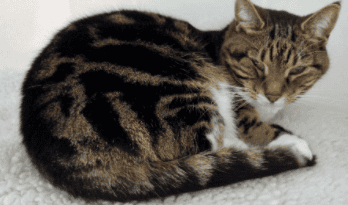Several sex-linked genes control the dominant coat color of cats (black/orange, light/non-light, agouti/non-agouti, tabby/non-tabby, and white/non-white). Tortoiseshell coat color is a characteristic of female cats with two X chromosomes. Each X chromosome has a black allele and an orange allele. Therefore, a normal male cat with XY chromosomes will not have tortoiseshell coat color. The genes of tortoiseshell male cats are chimeras, rare mutations, or symptoms similar to human Klinefelter syndrome (that is, male patients with an extra X chromosome).

Some veterinarians believe that tortoiseshell cats are more moody than cats of other colors, but There is little research on cat temperament and coat color. Some surveys suggest that people view tortoiseshell cats as more aggressive than cats of other colors, but this evidence often relies on owners' descriptions of their pets and so may be biased. Most people prefer brightly colored pets to darker colored pets, which may be due to the lower adoption rate of black cats. Cat coat color has been linked to a variety of diseases, including FeLV infection, hyperthyroidism, and hereditary deafness in white cats.
There are many time-honored stereotypes about the relationship between cat temperament and coat color (Figure 1). The reality is that most veterinarians blame bad behavior in tortoiseshell cats on their coat color.
While the terms "mischievous tortoiseshell" and "laid back black cat" do exist in general, is there really a relationship between a cat's color and temperament? How is a cat’s coat color related to other diseases? What is the relationship between a cat’s coat color and its gender?

What is the relationship between coat color and gender?
The gene that controls cat coat color is located on the X chromosome. These genes have two mutually exclusive alleles: black and orange. A female cat with two X chromosomes carrying one orange allele and one black allele will be tortoiseshell. Only female cats that carry the orange gene on both X chromosomes will have orange hair. Since the black gene is more common among cats, orange cats are usually male.
Male cats with one X and one Y chromosome are either black or orange, depending on which allele they carry on the X chromosome. A male cat can never have tortoiseshell coat color because that color requires both black and orange alleles to be present.
Therefore, male tortoiseshell cats are either male cats with Klinefelter syndrome (XXY) or rare genetic mosaics derived from different fertilized eggs (XX-XY or XY-XY) .
Due to the mutation of the orange gene in the cells into the black gene during fetal development, male tortoiseshell cats that can reproduce will also appear. This situation is extremely rare.

 扫一扫微信交流
扫一扫微信交流
发布评论